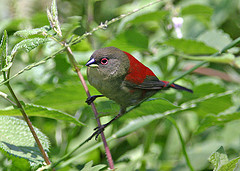Salvadori's Berga deer
| Salvadori's Berga deer | ||||||||||||
|---|---|---|---|---|---|---|---|---|---|---|---|---|

Salvadoris Berga deer, male |
||||||||||||
| Systematics | ||||||||||||
|
||||||||||||
| Scientific name | ||||||||||||
| Cryptospiza salvadorii | ||||||||||||
| Reichenow , 1892 |
Salvadori's Bergastrild ( Cryptospiza salvadorii ), also known as Salvadori Astrild , is a species from the finch family . It occurs exclusively in East Africa . There it is common in places, but the range is very disjoint.
Salvadoris Bergastrild was scientifically described in 1892 by the German ornithologist Anton Reichenow in the Journal für Ornithologie . Three subspecies are currently recognized for this species. The IUCN classifies the Bergastrild as not endangered ( least concern ).
description
Salvadori's Bergastrild reaches a body length of twelve centimeters. The male has a greenish olive head, the back and rump are dark carmine red. The chin and throat are lighter than the rest of the underside and can vary between straw yellow and pale olive depending on the subspecies. Some of the wing-top feathers have distinctly red lace hems, the inner arm wings have wide crimson outer hems. The sides of the body have more or less extensive carmine-red spots. The color of the plumage varies greatly with wear and tear and can be brown, green or gray. The eye is dark brown with a red eyelid, the beak is black.
The females are similar to the males, but are generally a little more dull in color and have less red on the sides of the body.
Distribution area and way of life
Salvadori's Bergastrild occurs in the mountains of East Africa. Its distribution area extends from the south of Sudan and Ethiopia to the mountainous countries in the northwest of Lake Tanganyika and the north of Tanzania . It inhabits both the interior and the peripheral areas of dense mountain forest and also occurs in thickets of banks on streams and rivers. Its height distribution ranges from 1500 by 3000 meters.
Salvadori's Bergastrilde live individually, in pairs or in small groups of up to six individuals. In Kenya , however, troops of up to fifty individuals have already been observed eating growing grass seeds in the margins of agricultural areas. The Salvadorean Bergastrild feeds on small seeds, especially on types of millet . He also eats the seeds of spring herbs . Probably insects also play a role in his diet. Most of the food is found on the ground. Like other species of Bergastrilde, Salvadori's Bergastrild is a shy and difficult to watch bird. In the event of disturbances, he immediately looks for cover in the foliage.
The nest is built from grass and fibers and is two to four meters above the ground. It is a ball nest that occasionally has a side entrance up to five centimeters long. The clutch consists of three to five eggs. The breeding season varies depending on the distribution area.
attitude
Salvadori's Bergastrilde was first imported to Europe in 1933 and shown at the London Zoo . To this day, however, they are only rarely offered in stores and rarely kept. Offspring are accordingly rare. Similar to Reichenow's Bergastrild , Salvadori's Bergastrild also needs well-structured aviaries with appropriate retreats.
supporting documents
literature
- C. Hilary Fry and Stuart Keith (Eds.): The Birds of Africa. Volume VII. Christopher Helm, London 2004, ISBN 0-7136-6531-9 .
- Jürgen Nicolai (Ed.), Joachim Steinbacher (Ed.), Renate van den Elzen, Gerhard Hofmann, Claudia Mettke-Hofmann: Prachtfinken - Afrika , Series Handbuch der Vogelpflege, Eugen Ulmer Verlag, Stuttgart 2007, ISBN 978-3-8001- 4964-3
Web link
- Cryptospiza salvadorii inthe IUCN Red List of Threatened Species 2013.1. Listed by: BirdLife International, 2012. Retrieved October 16, 2013.